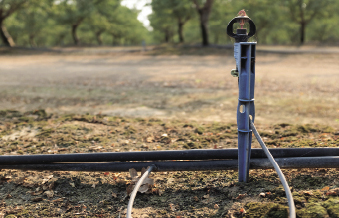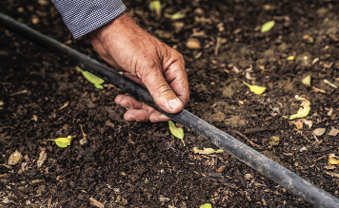Almond growers cut water use with efficiency measures
By Bob Johnson

Photo/Courtesy Almond Board of California

Photo/Courtesy Almond Board of California
California almond growers have reduced the amount of water needed to produce a nut by 33% since 1990 by investing heavily in well-managed microsprinkler and drip irrigation systems. They aim to further reduce their drops per crop another 20% by the year 2025, according to the Almond Board of California.
But the question lingers as to how much of the $6 billion industry can sustain itself in the face of worsening water shortages. As drought and regulations restrict available water, another 350,000 nonbearing acres of trees already in the ground will eventually come into production and need water.
It will be some time before it is possible to assess the toll drought and regulatory restrictions on water use have already taken this year in terms of reduced almond yields and impacts of growers removing orchards when irrigation supplies run out.
"We look back to prior droughts, and yields were reduced due to deficit irrigation," said Richard Waycott, president and CEO of the Almond Board. "Some growers took out orchards or parts of orchards so they would have enough water for the rest. There is a lot of talk about smaller kernels, but maybe we'll reach the estimate of 2.8 billion pounds."
While media reports have focused on growers pulling out almond trees they could not irrigate, an even larger number of almond farmers may have chosen to replant older blocks during the drought.
Replanting almonds may buy some time because typically the ground is left fallow or planted in cover crops or annuals for a year or two before replanting after an older orchard is chipped and incorporated into the ground.
As they look toward an uncertain water future, almond growers can take comfort in their decades-long investment in the equipment and information needed to get the most out of every drop.
"The Almond Board of California began investing in research in 1982 to determine if a new irrigation method—micro-irrigation—could work in almond orchards," according to an Almond Board statement on its water efficiency effort called Getting the Most Out of Every Drop.
The statement said, "Today, 85% of California almond farms use micro-irrigation, nearly two times the rate of California farms overall."
Drip and microsprinkler irrigation have made it possible to improve water- use efficiency by precisely delivering the needed amount of water to the root zone, reducing losses to evaporation, leaching and runoff.
Even following the 33% improvement in water-use efficiency, Waycott said he is confident the industry is well on its way to achieving another 20% in conservation by 2025.
"It looks good with the conversion to modern irrigation systems and the growers dialing in their fertigation practices," he said. "We also have some new varieties and orchards planted more densely."
The almond industry has used its resources to finance research on how to use micro-irrigation to water the crop efficiently and develop software tools that let growers take that information into the field.
The Almond Board has developed, for example, software that lets growers generate irrigation run-time schedules based on local evapotranspiration figures from nearby weather stations and information about individual orchards and irrigation systems.
Linked to the nearest California Irrigation Management Information System station, this tool automatically integrates current weather information. That makes it easier to calculate an orchard's irrigation needs.
The California Almond Sustainability Program has developed a series of self-evaluation modules that let growers evaluate where their practices stand compared to the industry average and where they should focus time and resources to improve.
The irrigation module begins by asking if the current owner planted the orchard and whether soil maps and aerial or satellite photography were used to identify differences within an orchard block that could affect water needs.
Other sections of the module ask about the design and maintenance of the irrigation system and the use of sensors to determine crop water needs.
The evaluations help growers decide where they could become more efficient in their irrigation. They can see how they compare with other growers, create a record of industrywide practices and even fill out reports required by regulators.
"Between the 1990s and 2010s, almond growers reduced the amount of water needed to grow each pound of almonds by 33% with improved production practices and adoption of efficient micro-irrigation technology," according to the Almond Board sustainability goals. "By 2025, the California almond community commits to reduce the amount of water used to grow a pound of almonds by an additional 20%."
As almond growers scramble during the drought to find enough water to irrigate this year's crop, they face an even greater challenge in the future. This is specific to balancing groundwater supplies as required by the Sustainable Groundwater Management Act, or SGMA, signed by Gov. Jerry Brown in 2014.
Under the regulation, local groundwater sustainability agencies had to develop groundwater sustainability plans by 2020 for critically overdrafted basins, and by 2022 for other high- and medium-priority basins. The plans must show how sustainability will be achieved within 20 years of their completion with the main goal of ensuring that groundwater pumping, on average, does not exceed recharge.
Water shortages due to SGMA could cause 1 million acres of San Joaquin Valley farmland to be fallowed and cost as many as 85,000 jobs, according to a 2020 report by University of California, Berkeley, economists David Sunding and David Roland-Holst.
The report adds that the 1 million acres of land would be fallowed during a period of two to three decades and would represent about one-fifth of San Joaquin Valley land currently in cultivation. The anticipated farm revenue loss associated with the fallowing would be $7.2 billion per year, the report said, equal to roughly 14% of California's total farm production.
Almond orchards are included in the tally of acreage that is expected to be fallowed, Waycott said, adding that local groundwater sustainability plans were submitted to the California Department of Water Resources two years ago.
While SGMA will restrict the use of well water significantly in some areas, the law allows pumping restrictions to be phased in over a 20-year period, so the slope of the changes could be gradual.
(Bob Johnson is a reporter in Monterey County. He may be contacted at bjohn11135@gmail.com.)
Permission for use is granted, however, credit must be made to the California Farm Bureau Federation when reprinting this item.




